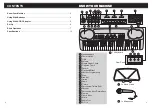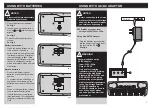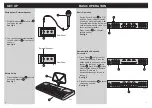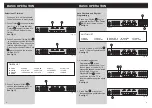
8
9
fig. 11
fig. 12
fig. 13
fig. 14
fig. 15
fig. 16
fig. 17
BASIC OPERATION
BASIC OPERATION
Q
Q
R
K
S
U
F
L
K
M
Selection of Timbres
-
When you turn on the keyboard,
the default choice is piano timbre.
1. Press Timbre Q to choose timbres
from No.1 to 8. Press the other
Timbre Q to select timbres 9 to
16. (Press one button for one
timbre).
See fig. 11
2. Press Percussion/Timbre Shift R
to change percussion function to
timbre function. Then choose the
relative timbre keys from 1 to 8.
Press the Percussion/Timber Shift
R again to choose the relative
timbres 9 to 16.
See fig. 12
1. Press one Rhythm S key for
automatic rhythm. Press Tempo
U for 32-level tempo control.
See fig. 14
TIMBRE LIST
01 PIANO
02 HARP
03 ORGAN
04 BELL
05 J-GUITAR
06 VIOLIN
07 STRING
08 GUITAR
09 TRUMPET
10 TUBA
11 E BASS
12 SAXOPHONE 13 FLUTE
14 BANJO
15 OBOE
16 HORN
Auto Rhythms and Rhythm
Programming
RHYTHM LIST
01 DISCO
02 8 BEAT
03 ROCK + ROLL 04 RHUMBA 05 TANGO
06 MARCH
07 COUNTRY 08 BOSSA NOVA 09 WALTZ
10 CHA-CHA
2. In rhythm mode, press Fill-In F
to add 1-2 bars of special sound.
See fig. 15
3. After pressing Rhythm
Programming L , press
percussion buttons to edit your
chosen group of rhythms (16
percussion sounds can be stored
in the RAM). Press the
Playback/Effect K , to hear
percussion rhythms. To re-
program, please repeat the above
steps.
See fig. 16
4. Press Stop M or any other
function button to quit this function.
See fig. 17
3. Press Playback / Effect K to
choose reverberation, echo or
vibrato for enhanced effect.
See fig. 13








